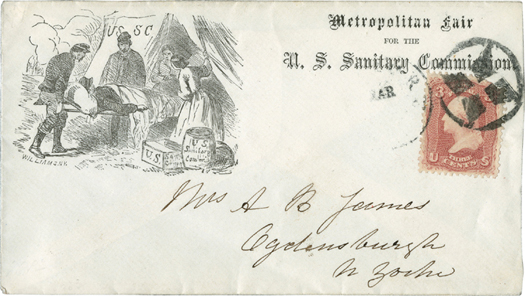
Thru the mercys of a kind God I am permitted to drop you a few lines to let you no that I am well & hearty.
PRIVATE DAVID W. WALTERS TO HIS WIFE, RACHEL, SEPTEMBER 1862
“I FEEL THAT OUR CONTRY NEEDS MY HELP & I AM willing to do all that I can & eaven give my life for your libertys & our beloved childs.” So wrote Private David W. Walters in the letter reproduced at right, written on September 29, 1862, to his wife, Rachel. This was the third letter that he sent to her during his first month in camp with Company I of the 5th Indiana Cavalry. Rachel was able to reply within a week from their home a hundred miles or so away and let her husband know how their one-year-old son, Willard, was doing.

Thru the mercys of a kind God I am permitted to drop you a few lines to let you no that I am well & hearty.
PRIVATE DAVID W. WALTERS TO HIS WIFE, RACHEL, SEPTEMBER 1862
Letters helped bridge the distance separating this couple and other friends and kin during the war. Mail service provided a vital link between soldiers and their loved ones and helped ease their concerns for each other in times of danger and distress. This letter from David Walters begins with reassuring words for Rachel. “My dear companion,” he writes, “Thru the mercys of a kind God I am permitted to drop you a few lines to let you no that I am well & hearty.” He and Rachel regularly sent each other news of family and friends along with photographs, money, and postage stamps to sustain their correspondence, which continued as he campaigned in Kentucky and Tennessee before advancing into Georgia with General William T. Sherman’s army in 1864. In May of that year, Rachel received word that he had been captured at Resaca, Georgia. Sadly, a condolence letter followed a year later, informing her that David had died of starvation at a Confederate prison camp in Florence, South Carolina, in February 1865.  LH
LH
LOVE AND HONOR While in camp at Indianapolis, Indiana, newly enlisted cavalryman David W. Walters penned this affectionate letter—which begins on the right-hand page and continues on the back—to his wife, Rachel. He enclosed it in a patriotic envelope bearing Union symbols and the abbreviations of all thirty-four states. Illustrated stationery like this envelope and those following—held at the Smithsonian National Postal Museum along with the correspondence of David and Rachel Walters—were purchased by soldiers and civilians on both sides of the conflict to show support for their cause.
Map of Washington, D.C., and portrait of General McClellan, 1861

Metropolitan Fair for the U.S. Sanitary Commission, 1864
